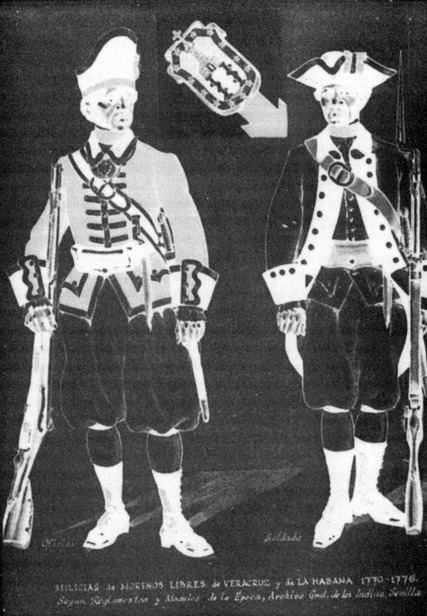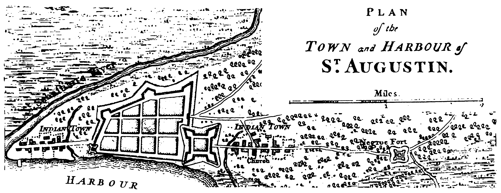The History of Florida (39 page)
Read The History of Florida Online
Authors: Michael Gannon
Tags: #History, #United States, #State & Local, #Americas

Southeast.
Other Africans remained with de Soto’s force for the duration. Ber-
naldo, a free caulker from Vizcaya and formerly the slave of one of de Soto’s
captains, survived the many bloody Indian battles, severe hunger, kil ing
marches, and final y a voyage down the Mississippi River in hastily con-
structed boats. After an epic voyage of more than four years, during which
the expeditionaries traversed 600 miles and ten of the present-day United
States, Bernaldo was among those who limped back to Mexico City dressed
only in animal skins.
Several more attempts failed before Pedro Menéndez de Avilés final y
established the first permanent settlement at St. Augustine in 1565. By that
time persons of African descent had already taken up residence in the pen-
insula. When Menéndez first explored his claim, he found a shipwrecked
mulatto named Luis living among the fiercely resistant Ais nation to the
south. Luis’s knowledge of the Ais language had saved other shipwreck vic-
tims whose freedom Menéndez negotiated, among them an unnamed black
woman. Luis became a translator for Menéndez and returned to live among
the Spaniards, but other “captives” chose to stay with the Indians. Menéndez
proof
complained later that slaves from St. Augustine ran to and intermarried
with the Ais. The possibility of an alternative life among the Indians would
temper race relations in Florida well into the nineteenth century.
Although a royal charter permitted Menéndez to import 500 African
slaves to do the difficult labor required in settling a new colony, he never
filled that contract, and probably fewer than fifty slaves may have accom-
panied the first settlers. The loss of those slaves who ran to the Ais was
significant. White manpower was in short supply in Florida, as it was in
other areas of the Caribbean, and Spaniards considered Indians to be too
weak, lazy, and transient to be a dependable labor force. Moreover, the na-
tive populations were extremely vulnerable to European diseases which had
already ravaged their counterparts in the Antilles. Thus, the slaves who re-
mained performed many critical functions in Spanish Florida, first at St.
Augustine and later at Santa Elena, Spain’s northernmost settlement, in
present-day South Carolina. Slaves logged and sawed the timber for fortifi-
cations and ships, built structures, and cleared and planted the fields, “with
no other expense but their oil and salt.”1 The Crown considered black labor
indispensable to the maintenance of Florida, noting that the entire govern-
ment subsidy would not suffice if wages had to be paid for their labor. By
Free and Enslaved · 183
the seventeenth century, the government was depending on royal slaves to
quarry coquina from Anastasia Island, make lime, load and unload govern-
ment ships, and row government galleys. Private owners of slaves employed
them in domestic occupations, as cattlemen and overseers on Florida’s vast
cattle ranches, and in a myriad of plantation jobs.
In times of crisis slaves and free Africans were also expected to help de-
fend the colony and provide military reserves for the badly understaffed
military garrison. After the late sixteenth century, the “Spanish Lake” was
infested with corsairs from England, France, and Hol and who raided Span-
ish shipping and settlements with seeming impunity. Florida’s long exposed
coastline made it particularly vulnerable to attack. By 1683 free blacks in St.
Augustine had formed themselves into a formal militia unit and were com-
manded by officers of their own election. Similar units served in Hispaniola,
Cuba, México, Puerto Rico, Cartagena, and throughout Central America.
The men who formed the black militias were usual y free black artisans
or skil ed workers. They were Catholics who lived as Spaniards and were
integrated into their communities through powerful social institutions such
as godparentage and patron/client networks. Leading useful and orderly
lives, they mirrored the early free African communities of Spain and en-
joyed the protections promised by Spanish law and custom. Military service
proof
was an important way for free blacks to prove themselves to their com-
munity and also to advance themselves through occasional opportunities
for plunder. Moreover, through the militias, free blacks acquired titles and
status and eventual y full military privileges. It is possible that the militia
units also functioned to reinforce relationships within the African com-
munity, as “natural” leaders rose to command and assumed responsibility
for their men. Parish registers from St. Augustine show that militia families
commonly intermarried and served as godparents and marriage sponsors
for one another. Church records also suggest that the double connection of
family and military corporatism may have worked to move some men out
of slavery. Although their slave past was certainly not forgotten, it was in a
sense excused by appropriate behavior, valuable services, and the sponsor-
ship of Africans of whom the community already approved.
Michael Mul in’s recent study of slavery in the contemporary British
Caribbean demonstrates how geographic context and the organization of
labor shaped the institution of slavery. In Florida slavery exhibited a num-
ber of the features that Mullin contends mitigated its oppressive nature: it
was general y organized by the task system, and slaves had free time to en-
gage in their own social and economic activities; slaves were able to utilize
184 · Jane Landers
the resources of both frontier and coast to their advantage; the trade in
slaves was never massive; and the paternal model of plantation management
prevailed, even on Florida’s largest ranches and plantations. Moreover, the
geopolitical pressures exerted by Spain’s circum-Caribbean rivals meant ad-
ditional leverage for slaves and more Spanish dependence upon free people
of color.
In 1670 English planters from Barbados challenged Spain’s claim to ex-
clusive control of the Atlantic seaboard by establishing Charles Town. St.
Augustine lacked sufficient force to mount a major attack against the usurp-
ers, but Spanish governors initiated a campaign of harassment against the
English colony that included slave raids by the Spaniards and their black
and Indian allies. These contacts may have pointed the way to St. Augus-
tine and suggested to English-owned black slaves the possibility of a refuge
among the enemy, for in 1687, after a dramatic escape by canoe, eight men,
two women, and a nursing child appeared in Florida. The fugitive slaves
requested religious sanctuary in St. Augustine, and, despite an early am-
biguity about their legal condition, only in one known example were the
runaways returned to their English masters. The rest were sheltered in St.
Augustine, instructed and baptized in the Catholic faith, married, and em-
ployed, ostensibly for wages. Royal policy regarding the fugitives was final y
proof
set in 1693 when Charles II granted the newcomers to Florida freedom on
the basis of religious conversion, “the men as well as the women . . . so that
by their example and by my liberality others will do the same.”2 In gratitude
the freedmen vowed to shed their “last drop of blood in defense of the Great
Crown of Spain and the Holy Faith, and to be the most cruel enemies of
the English.”3 The runaways had considered their options and made their
choices.
During the next decades more fugitives from Carolina flowed into St.
Augustine, and in 1738 the Spanish governor established the freedmen and
-women in the town of Gracia Real de Santa Teresa de Mose, about two
miles north of St. Augustine. Florida’s governor recognized the group’s
spokesman and the captain of their newly formed militia, Francisco Mené-
ndez, as the “chief” of Mose and referred to the others living at the vil age as
his “subjects.” The residents of Mose established complex family and fictive
kin networks over several generations and successful y incorporated into
the founding group incoming fugitives, Indians from nearby vil ages, and
slaves from St. Augustine. Community and familial ties were further rein-
forced by a tradition of militia service at Mose.

proof
Many former slaves and free African Americans served in Spanish militias in Florida
and throughout the circum-Caribbean in the eighteenth century. The soldiers depict-
ed here were posted at Havana, Cuba, and Veracruz, México.
186 · Jane Landers
However, despite the best efforts of Menéndez and his men, the first town
of Mose was destroyed when General James Oglethorpe commanded a joint
naval and land assault against St. Augustine in 1740. Mose’s inhabitants took
up residence in St. Augustine until Governor Fulgencio García de Solís at-
tempted to relocate the freedmen to Mose in 1752. The former residents
feared further attacks and did not want to move back, but after the governor
promised to fortify the settlement better and to post soldiers at the site, the
freedmen rebuilt Mose, constructing a church and a house for the Francis-
can priest within an enclosed fort as well as twenty-two shelters outside the
fort for their own households.
Kathleen Deagan of the Florida Museum of Natural History directed an
interdisciplinary investigation of Mose that has added to the documentary
record archaeological, or material, evidence about daily life at this unique
site. In two seasons of excavations her team uncovered the foundations and
earthen walls of the fort, parts of the palisade, sections of the moat, and
several of the interior structures. They also recovered military artifacts such
as bullets, gunflints, and buttons and domestic items such as bone buttons,
pins and thimbles, clay pipe bowls, beads, and a variety of eighteenth-cen-
tury ceramics and bottles. One valuable find was a handmade pewter St.
Christopher’s medal, which may be a reference to the Africans’ travels over
proof
water or suggest links to Havana, for which St. Christopher was the patron.
While conditions at Mose were rugged, the homesteaders were at least
free to farm their own lands, build their own homes, and live in them with
their families. A house-by-house census of Mose from 1759 identified
thirty-seven men, fifteen women, seven boys, and eight girls living at the
site. Included were members of the Mandinga, Congo, and Carabalí nations,
as well as many others, but over time the diverse ethnic-linguistic groups
formed a cohesive community that survived until 1763. Then, through the
fortunes of war, Spain lost Florida to the British, and the Spanish Crown
evacuated St. Augustine and its black and Indian allies to Cuba.
Under British rule (1763–84), black freedom in Florida became only a re-
mote possibility. Anglo planters established vast indigo, rice, sugar, and sea
island cotton plantations modeled after those in South Carolina and Geor-
gia. Historian Daniel L. Schafer has found that wealthy planters, such as
Richard Oswald and John Fraser, imported large numbers of African slaves
from Sierra Leóne for the back-breaking work involved in establishing new
plantations. Soon Africans were the most numerous element of Florida’s
population. The American Revolution accelerated that trend, for after the
Patriots took Charleston and Savannah, planters shifted whole work forces

